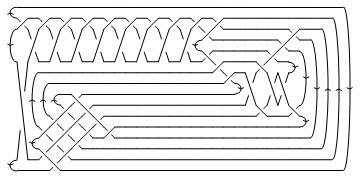Cabling: Difference between revisions
From Knot Atlas
Jump to navigationJump to search
No edit summary |
No edit summary |
||
| Line 4: | Line 4: | ||
{{Startup Note}} |
{{Startup Note}} |
||
<!--$$Import["http://katlas.org/wiki/CableComponent.m&action=raw"];$$--> |
<!--$$Import["http://katlas.org/wiki/CableComponent.m&action=raw"];$$--><!--END--> |
||
<!--$$CableComponent[BR[3, {1, 2}], Knot[3, 1]] // DrawMorseLink$$--> |
<!--$$CableComponent[BR[3, {1, 2}], Knot[3, 1]] // DrawMorseLink$$--> |
||
<!--Robot Land, no human edits to "END"--> |
<!--Robot Land, no human edits to "END"--> |
||
Revision as of 18:29, 18 November 2007
CableComponent[BR[n,js],K], whose code is available here, returns the -th cable of the knot with the braid on strands with crossings js = {j1, j2, ...} inserted in it. It also performs the necessary number of -twists on the components of the cable to compensate for a non-zero writhe number of the original knot. Cabling knot 3_1, for instance, and inserting the braid BR[3,{1,2}], we get:
(For In[1] see Setup)
In[3]:=
|
CableComponent[BR[3, {1, 2}], Knot[3, 1]] // DrawMorseLink
|

| |
Out[3]=
|
-Graphics-
|
For some special cases, we can check our result using Burau's Theorem.


